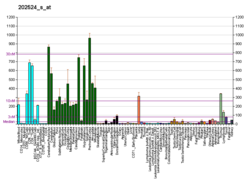
Osteoglycin, encoded by the OGN gene, is a human protein.

Lysine N-methyltransferase 2C (KMT2C) also known as myeloid/lymphoid or mixed-lineage leukemia protein 3 (MLL3) is an enzyme that in humans is encoded by the KMT2C gene.

Calcium-binding and coiled-coil domain-containing protein 1 is a protein that in humans is encoded by the CALCOCO1 gene.

DnaJ homolog subfamily B member 9 is a protein that in humans is encoded by the DNAJB9 gene.

Brevican core protein is a protein that in humans is encoded by the BCAN gene. Brevican is a member of the lectican protein family.

Spondin-1 is a protein that in humans is encoded by the SPON1 gene. It is secreted by cells of the floor plate and may be involved in axon guidance The protein contains 807 amino acids and is structurally composed of six thrombospondin domains, one reelin domain, and one spondin domain.

Serine/threonine-protein kinase SIK2 is an enzyme that in humans is encoded by the SIK2 gene.

Ergosterol biosynthetic protein 28 is a protein that in humans is encoded by the ERG28 gene.

Signal-induced proliferation-associated 1-like protein 1 is a protein that in humans is encoded by the SIPA1L1 gene.

PDZ domain-containing protein 11 is a protein that in humans is encoded by the PDZD11 gene.

TIMMDC1 is a protein that in humans is encoded by the TIMMDC1 gene. It is a chaperone protein involved in constructing the membrane arm of mitochondrial Complex I. A frameshift mutation in an intron of this gene has been shown to cause failure to thrive, retardation of psychomotor development, infantile-onset hypotonia, and severe neurologic dysfunction. High expression of this gene has been associated with migration of lung cancer cells while depletion of the protein has been shown to affect regulation of apoptosis, the cell cycle, and cell migration.

Zinc finger CCHC domain-containing protein 2 is a protein that in humans is encoded by the ZCCHC2 gene.

Uncharacterized protein C6orf89 is a protein that in humans is encoded by the C6orf89 gene.

Synaptotagmin-13 is a protein that in humans is encoded by the SYT13 gene.

Protein LMBR1L is a protein that in humans is encoded by the LMBR1L gene.

Zinc finger protein 471 is a protein that in humans is encoded by the ZNF471 gene.

RING finger protein 10 is a protein that in humans is encoded by the RNF10 gene.

Chondroitin sulfate proteoglycan 5 is a protein that in humans is encoded by the CSPG5 gene.

Fibronectin leucine-rich repeat transmembrane protein FLRT2 is a protein that in humans is encoded by the FLRT2 gene.

Teashirt homolog 3 is a protein that in humans is encoded by the TSHZ3 gene. In mice, it is a necessary part of the neural circuitry that controls breathing. The gene is also a homolog of the Drosophila melanogaster teashirt gene, which encodes a zinc finger transcription factor important for development of the trunk.




















